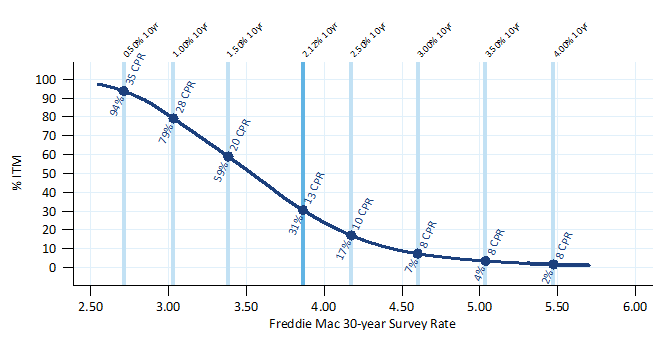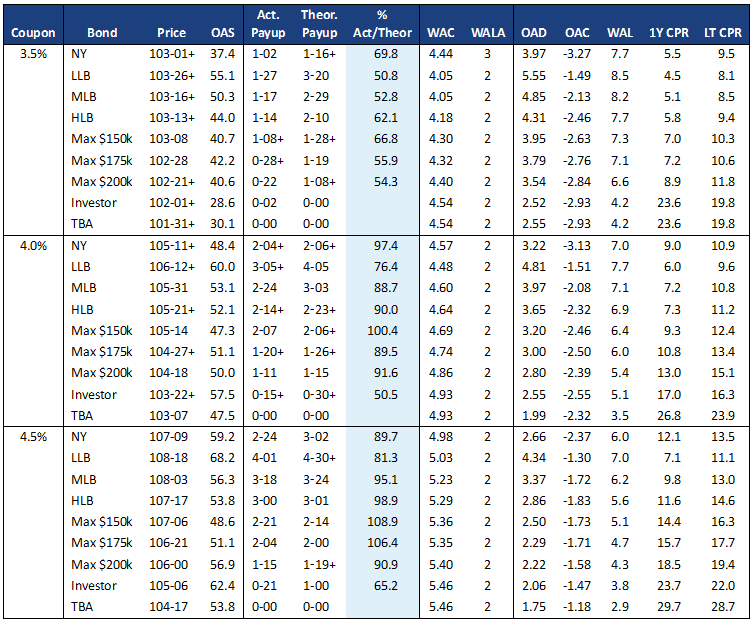Uncategorized
Not a refi wave. Yet.
admin | June 7, 2019
This document is intended for institutional investors and is not subject to all of the independence and disclosure standards applicable to debt research reports prepared for retail investors. This material does not constitute research.
Mortgage rates have fallen significantly over the last few weeks after falling steadily since October, fueling new concern about a pick-up in refinancing. Much of the mortgage market nevertheless carries note rates that still leave the refinancing incentive out-of-the-money, limiting the risk of a broad prepayment spike unless rates drop sharply. The exceptions are newer loans, which generally have higher note rates, are easier to refinance and could see some refi heat. Specified pools meanwhile have priced to rich levels with the exception of investor pools, which look like inexpensive options on lower rates.
Rates aren’t low enough for most borrowers to refinance
The primary mortgage rate currently stands at 3.82% according to the most recent Freddie Mac primary mortgage market survey. But this is only low enough to push 31% of the market more than 75 bp in-the-money to refinance (Exhibit 1). This is enough to push speeds over the course of a year on the average 30-year MBS to 13 CPR. Of course, seasonality will push actual speeds faster in the summer months and slower in the winter months.
Exhibit 1: Most 30-year mortgages are not in-the-money

Note: the y-axis shows the percentage of the MBS universe that is at least 75 bp in-the-money, and the average expected prepayment speed is printed at various points along the curve. The speeds printed represent an average level over the course of a year; seasonality will push actual speeds faster in the summer months and slower in the winter months. Source: Amherst Pierpont Securities.
It would take substantially lower rates to push prepayment speeds back to the 30 CPR area last seen in 2012 and 2013. Primary mortgage rates would need to drop to roughly 3.0%, which would likely take a 1.0% 10-year Treasury rate.
The spread between primary and secondary mortgage rates also tends to buffer the impact of broad drops in interest rates. Primary/secondary spreads often widen as interest rates rally, which also helps reduce the effect of lower rates on mortgages. The primary/secondary spread is calculated by comparing each Thursday’s Freddie Mac primary market survey release to the mortgage current coupon posted from Monday through Wednesday, which corresponds to the survey period. Primary/secondary spreads had averaged roughly 80 bp to 85 bp in April and early May but have already jumped to 95 bp with the most recent rally.
The refi index has hardly moved
The MBA refinance index also suggests that rates are not low enough to trigger a huge refinance wave. The index has not reacted much to the recent rally (Exhibit 2). In fact, the index was much higher when rates dipped in late March.
Exhibit 2: MBA refinance index

Source: MBA, Bloomberg, Amherst Pierpont Securities
But certain cohorts are exposed to faster speeds
At current mortgage rates the loans most likely to refinance have note rates of at least 4.5%. This means most cohorts with coupons 3.5% or lower shouldn’t be too sensitive to lower rates. However, starting in late 2018 originators have been delivering loans into much lower coupons than typical, raising the gross WAC of new production cohorts. For example the 2019 vintage 3.5%s have a substantially higher gross WAC than normal, 4.54%. This is similar to with the gross WAC of a typical 4.0% cohort of earlier vintages. A substantial number of loans in that cohort and other 4.0% cohorts, as well as loans in higher coupons, should prepay much faster.
Recently originated loans can refinance very rapidly once they are at least six months seasoned. These borrowers tend to have an easy time providing documentation since they recently closed on the existing loan, and appraisals can often be reused if they aren’t too old. Therefore 2018 and 2019 vintage cohorts could react more rapidly than older vintages. Jumbo loans, and in Ginnie Mae pools VA loans, also tend to react quickly to lower rates. Jumbo borrowers can save more money by refinancing and VA borrowers have a good streamline refinance program available.
Low quality pools have driven pay-ups higher
The higher gross WAC pools created by originators will dominate the TBA deliverable for some time, since these pools prepay much worse than a pool with the same coupon but a lower gross WAC. This has suppressed prices for the TBA, which has pushed pay-ups for specified pools to extremely rich levels (Exhibit 3).
Exhibit 3: Most payups are extremely high

Note: calculation of the ratio of actual to theoretical pay-ups uses the April Fannie Mae major pool in each coupon to represent TBA. Source: Yield Book, Amherst Pierpont Securities
Many investors look at the ratio of actual pay-up to the theoretical pay-up calculated using a prepayment model. Each bond is run to the same OAS as that coupon’s TBA. Analysis using Yield Book’s TBA assumptions have not been adjusted to account for the higher gross WACs of 2019 pools. Therefore April issued Fannie major pools were used as a proxy for the TBA.
Even after benchmarking specified against major pools, the most inexpensive stories are trading at roughly 50% of theoretical value. Traditionally, most investors consider anything over 40% of theoretical to be too rich, so nothing looks very compelling.
One interesting exception is 30-year 3.5% investor loans, which trade only a few 32s above TBA. Pools of 30-year 4.0% investor loans trade $0-15+ above TBA, and pools of 4.5% investor loans trade $0-21 above TBA. That effectively gives the investor an option on falling rates: if rates rise the investor delivers the pool into TBA and loses the initial pay-up, but if rates fall the pay-up rises substantially.
Price compression across the stack presents an opportunity
However, the worsening of TBA prices has also compressed prices across the coupon stack, and this presents an opportunity to look at specified pools a little differently. Specified pools naturally have a longer duration than their TBA since they prepay more slowly. Since the TBA is worsening this difference is even greater, making it much more difficult to hedge spec pools with the same coupon TBA. Instead, investors should consider hedging with a lower coupon TBA, which naturally has a longer duration.
Typically one downside is that using a lower coupon hedge is more costly since the dollar price of the hedge is lower. But the coupon stack has compressed substantially this year. For example, the price difference between 3.5%s and 3.0%s compressed to $1-20+ from $2-12+ earlier this year. This makes it more feasible to hedge with a lower coupon.
For example, consider hedging a 3.5% Max $175,000 pool. Exhibit 4 shows analytics for Yield Book’s TBA assumption as well as a more realistic view of what the worst to deliver collateral will look like.
Exhibit 4: TBA comparison

Source: YieldBook, Amherst Pierpont Securities
The Max $175,000 pool has a duration of 3.79 years (Exhibit 3) while the 3.0% TBA has a duration of 3.77 years, for a 1.0 hedge ratio. A market-value neutral hedge will therefore be pretty close to duration neutral. However, the hedge ratio to the 3.5% TBA is roughly 1.5, meaning that a market-value neutral hedge will have significant exposure to rate moves. Compared to hedging with the same-coupon TBA, the investor benefits from the additional carry from hedging with a lower coupon TBA. The investor also stands to benefit if the stack widens back to more typical levels.


